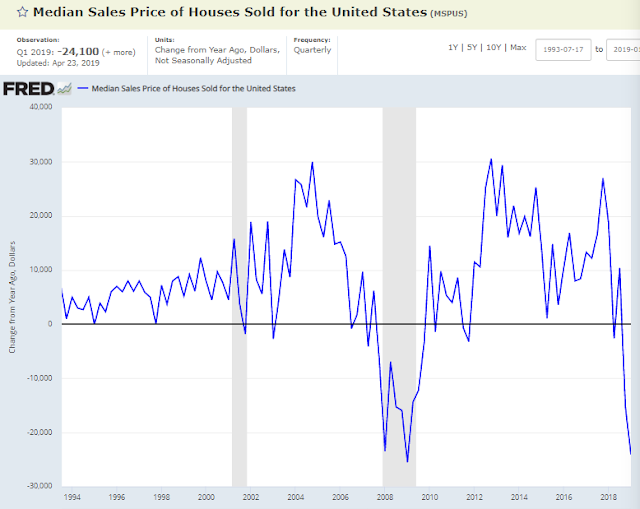No bearish blogger can compete with the re-allocation of $200+ trillion in global assets from risky to riskiest taking place at the end of the best first half in two decades. Attended by human history's largest tsunami of industry bullshit. The popular delusion in 2007 was that garbage mortgages could be packaged together into a lump of coal and come out the other side a AAA-rated diamond. The popular delusion in this era is on a magnitude that dwarfs the last one - the ubiquitous belief that printed (free) money is the secret to effortless wealth...
One of the reasons why the Democrats can't find their ass with both hands ahead of 2020 is because they too have been propagating the popular delusion that low interest rates improve the economy. Ironically, Trump got elected due to "free money" funding the steady erosion of the middle class, yet now he propagates the delusion more than anyone else.
Despite ever-more "free money", the quality of jobs in the U.S. has deteriorated for four decades straight, as has the quality of benefits. Underemployment is the biggest economic issue of our time, seldom discussed, and NEVER addressed. Trapped in a deflationary death spiral - cheap capital funding more automation - leading to cheaper capital.
Until politicians stop propagating popular delusion and hence always looking for gimmicks and simple solutions, nothing will change. The steady erosion of the middle class will continue.
Case in point, some Democratic candidates are talking about printing up some free money and using it to write-off all student loans.
What they should really do if they wanted to solve the problem, is instead of printing up a big pot of money, they should just make student loans legally dischargeable in bankruptcy, the same way EVERY OTHER kind of debt can be discharged. That would allow borrowers to make their own choice - some would file bankruptcy, others with small loans would continue paying, but then it would also "discentivize" future bad lending practices.
After 2008, the enslavement of a generation went into over-drive, compliments of popular delusion, and societal moral bankruptcy. You know it's bad when even the banksters are against bad lending:
"JPMorgan CEO Jamie Dimon sounded off on the massive student debt crisis he says is crippling Americans and wiping out the middle class"
Getting back to the topic of gambling and where things stand now, first level set to the 2016 Shanghai Accord.
The optimists say this is mid-2016 but with an impending rate cut. Us "pessimists" say this is 2016 with a trade war - the Shanghai Discord.
Not everyone can be right.
This time around, us realists have the bond market on our side. The yield curve (below) indicates that long-term bond yields are now lower than short-term bond yields. Which normally makes no sense - why would anyone accept a lower yield on a riskier (longer-term) bond? Because the market is saying that while rate cuts are indeed coming, the Fed is way behind the (yield) curve.
This has now all become a bet on the economy and the Fed's ability to pull it out of recession, despite their limited ammo and the fact that they are once again behind the (yield) curve:
Bear in mind that the tools central banks have to "reflate" the economy have the same lubricating effect on risk markets at the end of the cycle as they do at the beginning. Meaning that all of this yield curve collapse and attendant rate cut talk is pushing investors further out on the risk curve, late in the cycle.
Late cycle, early cycle, what's the difference?
The difference goes back to subprime and economic risk. There was a point in time during 2007/2008, as documented in the book and movie "The Big Short", when in fact the insurance (CDS) risk premium on subprime bonds went DOWN, even as economic risk rose. Why? Because ironically, as the global economy deteriorated, central banks pushed yields lower, causing a late cycle yield-seeking rush into risk. Those betting AGAINST subprime took their biggest drawdowns right before the crash.
That's where we are right now in the cycle.
Everyone knows that corporate debt is the next subprime, but they keep shoveling money at it, hoping insolvency will improve:
"Corporate borrowing poses a danger to the global financial system and could trigger a crisis in the same way US sub-prime mortgages sparked the 2008 banking crash"
a dramatic rise in borrowing in recent years by businesses with low credit scores means the market for corporate debt is becoming increasingly unstable...collections of low-grade corporate debts packaged for sale to investors, is reminiscent of the steep rise in their forerunner – collateralised debt obligations – that “amplified the sub-prime crisis”.
the most visible symptom of potential overheating is the remarkable growth of the leveraged loan market"
“I think one of the unintended, yet in hindsight predictable, outcomes of ZIRP [zero interest-rate policy] was to force investors into looking for returns anywhere they can find it”
The ad-sponsored media has done the most in propagating popular delusion. The quality of U.S. news at this juncture is the other side of dog shit.
This week in Barron's
Ignore Insane IPO Valuations. This Is Not A Bubble
What this all means is that the term "safe haven" is the most bastardized term on the planet.
Yes, again.
There's only one safe haven: "safe" being a relative term.
Gamble at your own risk.

























































